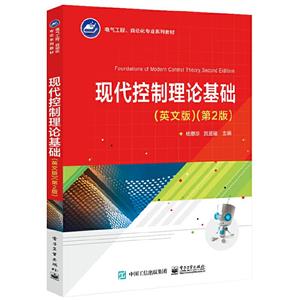扫一扫
关注中图网
官方微博
本类五星书更多>
-
>
中医基础理论
-
>
高校军事课教程
-
>
思想道德与法治(2021年版)
-
>
毛泽东思想和中国特色社会主义理论体系概论(2021年版)
-
>
中医内科学·全国中医药行业高等教育“十四五”规划教材
-
>
中医诊断学--新世纪第五版
-
>
中药学·全国中医药行业高等教育“十四五”规划教材
现代控制理论基础:英文版 版权信息
- ISBN:9787121414039
- 条形码:9787121414039 ; 978-7-121-41403-9
- 装帧:暂无
- 册数:暂无
- 重量:暂无
- 所属分类:>>
现代控制理论基础:英文版 内容简介
本书分8章, 主要内容包括状态空间分析法、数学基础知识、线性系统的状态响应、线性系统的可控性和可观性、李雅普若夫稳定性分析、线性系统的状态综合 (状态反馈、输出反馈和状态观测器) 和*优控制的基本方法。除第1章外, 其余各章均编写了多个应用型例题, 同时还配有一定数量的练习题和思考题, 帮助学生了解和掌握理论方法及其在工程实践中的应用。
现代控制理论基础:英文版 目录
Contents
Chapter 1 Introduction to Control Theory 1
1.1 Historical Review and Classical Control Theory 1
1.1.1 Historical Review of Automatic Control 1
1.1.2 Classical control theory 5
1.2 Modern Control Theory 7
1.3 Design of Control Systems 9
1.4 Outline of This Book 12
Chapter 2 Preliminary Mathematical Knowledge 14
2.1 Foundations of matrix algebra 14
2.1.1 Matrices 14
2.1.2 Algebraic operations with matrices 17
2.1.3 Matrix Operations 18
2.2 Vectors and Vector Spaces 20
2.2.1 Vector 20
2.2.2 Vector Spaces and Subspaces 23
2.3 Linear Algebra 26
2.3.1 Eigenvalue and Eigenvector of A Square Matrix 26
2.3.2 Linear Algebraic Equations 28
2.3.3 Similarity Transformation 29
2.3.4 Diagonal Form and Jordan Form 31
2.3.5 Cayley-Hamiton Theorem 36
2.3.6 Definiteness of A Scalar Function and Quadratic Form 38
Exercises 39
Chapter 3 State Variables and the State-Space Description of Dynamic Systems 41
3.1 State-Space Representation of Dynamic Systems 41
3.1.1 State and State Variables 41
3.1.2 State-Space Representation 44
3.1.3 Block Diagrams and Simulation Diagrams 50
3.2 Obtaining State Equations 52
3.2.1 From the Block Diagram 52
3.2.2 From Input-Output Representation 54
3.2.3 Equivalence Transformation of State-Space Representation 67
3.3 Transfer Function And Realizations 68
3.4 State-Space Representation of Linear Discrete-Time Systems 72
3.5 Summaries 76
Exercises 76
Problems 78
Chapter 4 Time Response of Linear Systems 80
4.1 Solution of LTI State Equations 80
4.1.1 Linear Homogeneous State Equations 80
4.1.2 The State Transition Matrix 83
4.1.3 Linear Nonhomogeous State Equations 87
4.2 Numerical Solution of State Equations 89
4.3 Solution of Linear Discrete-Time State Equations 92
4.4 Discretization of Continuous-Time Systems 94
Exercises 96
Problems 98
Chapter 5 Controllability and Observability 99
5.1 Corollaries of Cayley-Hamilton Theorem 100
5.2 Controllability and Observability of LTI Systems 101
5.2.1 Controllability Definition and Rank Criterion 101
5.2.2 Observability Definition and Rank Criterion 110
5.2.3 Controllable Canonical Form and Observable Canonical Form 115
5.2.4 Principle of Duality 118
5.3 Structural Decomposition of LTI systems 119
5.4 Controllability, Observability and Transfer Function 125
5.5 Controllability and Observability of Discrete-Time Systems 128
5.5.1 Controllability of Discrete-Time Systems 128
5.5.2 Observability of Discrete-Time Systems 131
5.5.3 Controllability and Observability After Sampling 133
Exercises 135
Problems 137
Chapter 6 Lyapunov Stability 139
6.1 Preliminary Examples 139
6.2 Stability Concepts 141
6.2.1 Equilibrium State 141
6.2.2 Stability Definitions 142
6.3 First Method of Lyapunov 144
6.3.1 Eigenvalue Criterion for Linear Time-invariant System 144
6.3.2 Eigenvalue Criterion for Linearized Time-invariant Systems 146
6.4 Second Method of Lyapunov 148
6.5 Lyapunov Equation 153
Exercise 155
Problems 156
Chapter 7 State Feedback and State Observer 157
7.1 State Feedback and Output Feedback 158
7.1.1 State Feedback 158
7.1.2 Output Feedback 160
7.2 Pole Placement using State feedback 161
7.3 Pole placement using Output Feedback 165
7.4 State Observer 167
7.4.1 Full-Dimensional Observer 167
7.4.2 Reduced-Dimensional State Observer 171
7.5 Feedback From Estimated States 175
7.6 The Engineering Applications of State Feedback and Observer 178
7.6.1 State Feedback Controller Design For The Inverted Pendulum[9] 178
7.6.2 Asymptotic Tracking And Disturbance Rejection 182
7.6.3 System Stabilization 188
7.6.4 System Decoupling 191
Exercises 197
Problems 199
Chapter 8 Optimal Control 201
8.1 Problem Formulation 201
8.2 Preliminaries:The extremum problem of functional 205
8.2.1 Functional and The Calculus of Variation 206
8.2.2 The Extremum Problem of Functional Without Constraints 210
8.3 The Variational Approach to Optimal Control Problems 221
8.4 Minimum Principle and Its Application 228
8.4.1 Pontryagin's Minimum Principle 228
8.4.2 Application of Minimum Principle 232
Exercises 243
Problems 245
Answers to Selected Exercises 248
Experiment 1: Modeling and Stability Analysis of the Inverted Pendulum System 252
Experiment 2: Design State Feedback Controller for the Inverted Pendulum System 255
References 257
展开全部
书友推荐
- >
自卑与超越
自卑与超越
¥13.5¥39.8 - >
伊索寓言-世界文学名著典藏-全译本
伊索寓言-世界文学名著典藏-全译本
¥6.1¥19.0 - >
回忆爱玛侬
回忆爱玛侬
¥10.5¥32.8 - >
山海经
山海经
¥20.4¥68.0 - >
名家带你读鲁迅:朝花夕拾
名家带你读鲁迅:朝花夕拾
¥10.5¥21.0 - >
新文学天穹两巨星--鲁迅与胡适/红烛学术丛书(红烛学术丛书)
新文学天穹两巨星--鲁迅与胡适/红烛学术丛书(红烛学术丛书)
¥9.9¥23.0 - >
有舍有得是人生
有舍有得是人生
¥14.9¥45.0 - >
唐代进士录
唐代进士录
¥17.1¥39.8
本类畅销
-
食品添加剂
¥33.5¥45 -
VB语言程序设计
¥29.9¥39.8 -
C语言程序设计习题与实验指导
¥9.1¥18 -
地下建筑结构-(第三版)-(赠课件)
¥49.4¥55 -
模具制图
¥37.8¥49 -
工程机械结构认知
¥10.5¥22


















